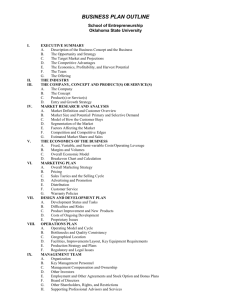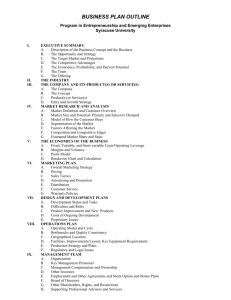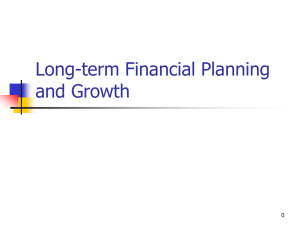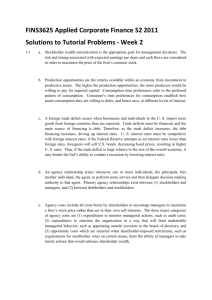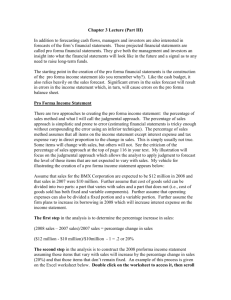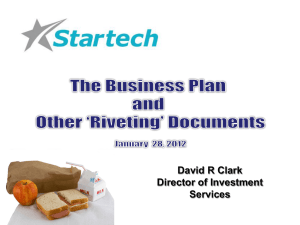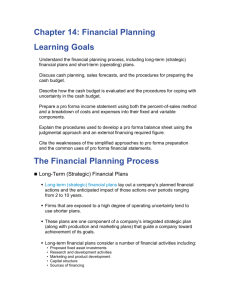Notes
advertisement
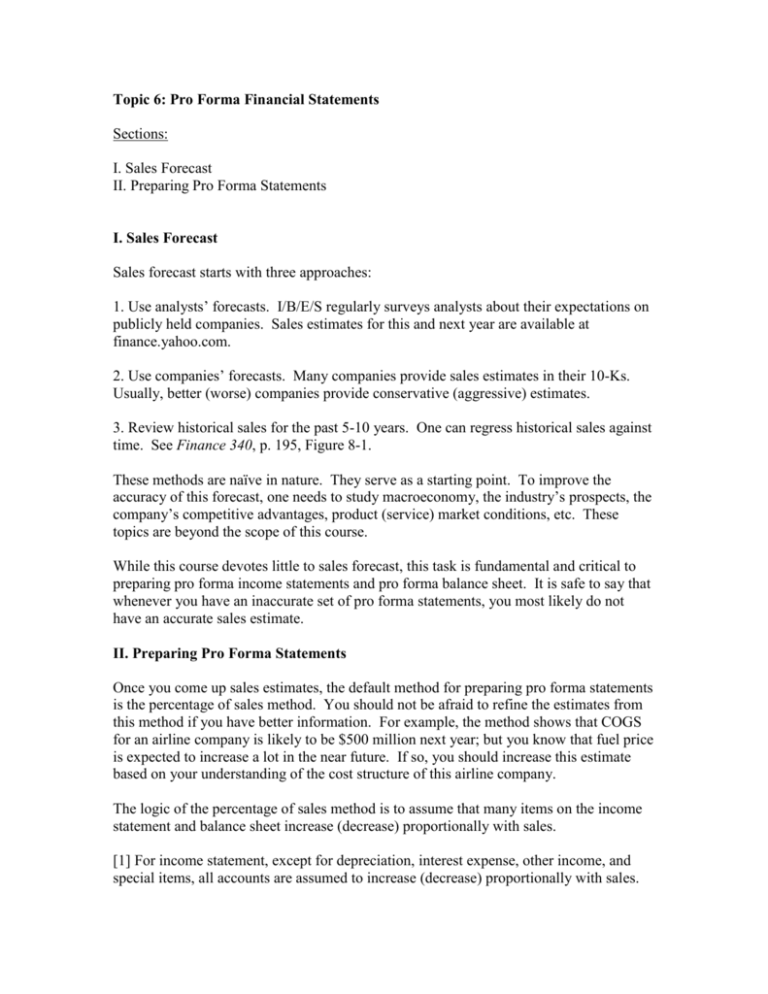
Topic 6: Pro Forma Financial Statements Sections: I. Sales Forecast II. Preparing Pro Forma Statements I. Sales Forecast Sales forecast starts with three approaches: 1. Use analysts’ forecasts. I/B/E/S regularly surveys analysts about their expectations on publicly held companies. Sales estimates for this and next year are available at finance.yahoo.com. 2. Use companies’ forecasts. Many companies provide sales estimates in their 10-Ks. Usually, better (worse) companies provide conservative (aggressive) estimates. 3. Review historical sales for the past 5-10 years. One can regress historical sales against time. See Finance 340, p. 195, Figure 8-1. These methods are naïve in nature. They serve as a starting point. To improve the accuracy of this forecast, one needs to study macroeconomy, the industry’s prospects, the company’s competitive advantages, product (service) market conditions, etc. These topics are beyond the scope of this course. While this course devotes little to sales forecast, this task is fundamental and critical to preparing pro forma income statements and pro forma balance sheet. It is safe to say that whenever you have an inaccurate set of pro forma statements, you most likely do not have an accurate sales estimate. II. Preparing Pro Forma Statements Once you come up sales estimates, the default method for preparing pro forma statements is the percentage of sales method. You should not be afraid to refine the estimates from this method if you have better information. For example, the method shows that COGS for an airline company is likely to be $500 million next year; but you know that fuel price is expected to increase a lot in the near future. If so, you should increase this estimate based on your understanding of the cost structure of this airline company. The logic of the percentage of sales method is to assume that many items on the income statement and balance sheet increase (decrease) proportionally with sales. [1] For income statement, except for depreciation, interest expense, other income, and special items, all accounts are assumed to increase (decrease) proportionally with sales. That is, if sales will grow at 10% next year, costs (expenses) estimate except depreciation will also increase by 10% next year. This assumption is based on the observation that when a firm has sales increase, the firm needs to purchase more raw materials and needs more labor hours, etc. Depreciation is usually based on the asset base. It seems more reasonable to forecast depreciation as a percent of net plant and equipment. In addition, many firms provide depreciation estimates; these numbers are usually of high quality. Interest expense is a function of a firm’s financing decisions which may be independent with the firm’s operations. The Finance 340 textbook advocates the following parsimonious method. First, identify the amount of interest-bearing debt at the beginning of the year. The projected interest debt = identified debt * (the expected borrowing rate + 0.5%). The extra 0.5% is added because most firms increase their debts throughout the year, so the identified debt at the beginning of the year is mostly likely understated. Note that the management may provide their estimates of future interest expenses in the 10-K. Other income may include one-time gain and loss. So one needs to read 10-K carefully to determine (1) whether historical observations of other income provide guidance for forecasting other income, and (3) whether some one-time other income transactions are expected and discussed in 10-K. Each special item has its own characteristics and needs to be examined individually. The rule of thumb is that if the item is one-time in nature, then its projected value is zero. In addition, estimates of equity earnings are based on investees’ sales potential rather than on investors’ sales potential. [2] For balance sheet, cash, accounts receivable, inventories, net plant and equipment, accounts payable, and accruals are usually assumed to increase (decrease) proportionally with sales. So the default method is to apply the percentage of sales approach to these accounts. Note that at times this treatment may not be appropriate for inventories and net plant and equipment. There may be economies of scale in inventories (Figure 8-2, p.211). As a result, inventories may grow less rapidly than sales. Fixed assets are often added in large, discrete units. In addition, there may be unused capacity in the exiting fixed assets. As a result, there may be no new fixed assets needed when sales increase moderately. Adding the additions to retained earnings (= NI available to common shareholders – dividends) in year T (income statement) to the retaining earnings in year T-1 you have the retained earnings in year T. Short-term investments, notes payable, long-term bonds, preferred stocks, and common stocks are “plug variables.” That is, at first we usually do not make any change to these numbers. And, of course, this often will not lead to a balance for the pro forma balance sheet. The difference between the right-hand-side and the left-hand-side of the statement is called “additional funds needed” (AFN) or external funds needed (EFN). If this number is positive, this means that the firm needs to raise money externally to support the firm’s growth. This amount can be financed by an increase in notes payable, long-term bonds, preferred stock, common stock, or a combination of the above. Usually, when this amount is small, it makes sense to assume that the firm will use notes payable to finance this need because N/P is much easier to obtain, potentially from the existing line of credit. Firms rarely raise preferred stock or common stock to fund AFN. If the AFN is negative, the firm has extra money. The firm may invest it in short-term investments, pay more dividends, retire some debts, or repurchase its common shares. Preparing pro forma statements is an iterative process. You frequently utilize common sense for the task. As a result, there is really no correct solution. You just do your best and hope that your estimates are not far away from the realizations. Now, let us work on the 2005 pro forma statements for Dell. Let us assume that the sales will grow at 20% in 2005. -----------------------------------------------------------------------------------------------------------Individual Project: Please use Excel to prepare pro forma statements and answer the questions raised in Problem (8-6), p. 216, i.e., the Stevens Textile problem. An Excel output are due in one week. ------------------------------------------------------------------------------------------------------------

